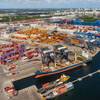North America’s largest mining, manufacturing and agricultural companies have helped identify four top priorities to improve the competitiveness of Great Lakes shipping, and as a result, the prosperity of the entire region.
These priorities will be the Chamber of Marine Commerce’s focus in the coming year.
“Our customers are critical to the viability of Great Lakes-Seaway shipping and the underlying economy. As one of our large industrial customers put it: No customer = no ships, no ports, no Seaway,” said Stephen Brooks, President of the Chamber of Marine Commerce. “Tough global economic conditions mean that our manufacturing, food, mining and construction sectors are under more pressure than ever to be competitive. We need governments to focus on creating world-class transportation networks that will help them succeed.”
The four priorities are: (1) invest in infrastructure, (2) harmonize regulations across borders, (3) reduce red tape and lower fees for government-mandated services and (4) make environmental regulations science-based.
“Using marine reduces truck traffic in our supply chain and extends our reach to support North American markets,” said Rick Ruzzin, Sr. Director of Logistics for Compass Minerals. “We need continued collaboration between industry and government on the costs of mandated services to reach sustainable outcomes for all stakeholders. To raise marine costs such that companies look to rail or truck, instead of vessel freight, would compromise our ability to compete against imports and negatively impact local business.”
James Reznik, St. Marys Cement (Votorantim Cimentos), Director Logistics — North America, said, “Some government-mandated services are necessary, but the fees are not always being used appropriately. In the U.S., we pay Harbor Maintenance Fees but only up to approximately 50 percent of the money is actually used for its intended purposes of dredging and maintaining ports and waterways. We frequently have to light load vessels because ports are not adequately dredged, which means more trips to carry our products and more costs.”
Tom Brown, Logistics Manager of LafargeHolcim, said, “Environmental regulations should absolutely be based on sound science. When regulatory requirements change it is very challenging from a planning perspective. It affects the development of new capacity and new business. Transportation is a significant cost component for limestone and cement. We also have to consider this from an environmental standpoint. Our quarries and plants are serviced by fuel-efficient ships that can carry 25,000 tons at a time. If we lose business to a land-locked competitor that transports only by truck, that could lead to more road congestion and air emissions.”












